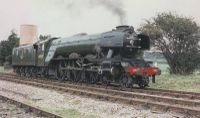LNER Class A3 4472 Flying Scotsman
No. 4472 (Originally it was 1472) Flying Scotsman is an LNER Class A3 (Originally A1) Pacific designed by Sir Nigel Gresley and built at Doncaster Works. It was later numbered 103. Following Nationalisation, British Railways renumbered it 60103. It pulled express trains on the East Coast Main Line from London King's Cross to Doncaster, Leeds, York, Newcastle-upon-Tyne, or Edinburgh. Most of its expresses were called "The Flying Scotsman Service", a namesake to it, from London to Edinburgh. In its career, the Flying Scotsman has travelled 2,000,000 miles (3,200,000 km).
During its time on the British Main Line Service, Flying Scotsman travelled 633 kilometres from London to Edinburgh in 8 hours without stopping, with water replenishment using the water trough system. For this period, it was fitted with a large 8-wheel tender which had a corridor connection to allow for a change of loco crew without the need to stop the train.
Contents
History
Construction on the locomotive ended in 1923 by the Great Northern Railway. It was originally built as an A1 but in January of 1947, it was rebuilt as an A3. Its original number was 1472.
It became a flagship locomotive for the LNER. It represented the LNER at the British Empire Exhibition at Wembley in 1924-1925. At that time, it acquired its name and the now-famous number 4472. From then on, it was used for promotional purposes.
It was the first of its class to haul the "Flying Scotsman Train", on its first non-stop service from London to Edinburgh on May 1, 1928. The next year, it appeared in the film "The Flying Scotsman".
On November 30, 1934, Flying Scotsman became the first locomotive to be officially recorded at going 100 miles per hour and earned a place in the land speed record for railed vehicles. The publicity-conscious LNER made this much of a fact.
After World War II, it was renumbered 103, and following Nationalisation in 1948, it was given the number 60103. It was fitted with a pair of smoke deflectors and a double chimney to improve steaming.
Preservation
In 1963, Flying Scotsman was withdrawn from service on British Railways and sold for preservation to Alan Pegler. It was restored to (or as close to as possible) the original LNER condition and worked on several rail tours, including a non-stop London to Edinburgh run in 1968. This was also the year that steam traction was officially ended on British Railways. It was also, at this time, fitted with a second tender to increase its water capacity, a move that divided opinions among enthusiasts.
In 1969, it went on a promotion tour in the U.S. where it had to be fitted with a cowcatcher, headlamp, bell, air brakes, and buck-eye couplings. At first, it was a success, but then Pegler's backers withdrew support and Pegler went bankrupt in 1972. Fears rose for the engine's future, the thought that it could live in the U.S. permanently, or even be scrapped. But in January of 1973, William McAlpine came in at the eleventh hour and had Flying Scotsman repaired and repatriated.
In 1988, Flying Scotsman went to Australia to take part in the bicentenary celebrations. It set another record there, going 442 miles from Parkes to Broken Hill non-stop. This was the longest run by a steam engine ever recorded.
More recently, Flying Scotsman continues to have an eventful live. In 1995 it was taken to pieces at Southall depot in West London and faced an uncertain future due to the cost of restoration and the refurbishment needed for Main Line operation. In 1996, Dr. Tony Marchington bought the loco and restored it to running condition at the cost of some £750,000.
In 2004 Flying Scotsman was put up for sale because of the mounting debts of its owning company. After a high-profile media campaign, it was bought in April by the National Railway Museum in York and is now part of the National Collection. On the way to York, it broke down and was recovered by a Class 37 on loan from West Coast Railways.
As of 2006, it is undergoing a major overhaul at the NRM and will not return to traffic until late 2007. The bay in which it is being repaired is able to be viewed by visitors, but it has been dismantled so much that only the footplate is recognizable.
Flying Scotsman is known and often referred to as "The Most Famous Steam Engine in the World"!
In Fiction
Flying Scotsman was featured in The Railway Series book "Enterprising Engines" by the Rev. W. Awdry. He visited Sodor to see this only remaining Gresley A3 brother, Gordon the Big Express Engine.
It is also featured in Microsoft Train Simulator, and the 2006 edition of Trainz Railroad Simulator.

